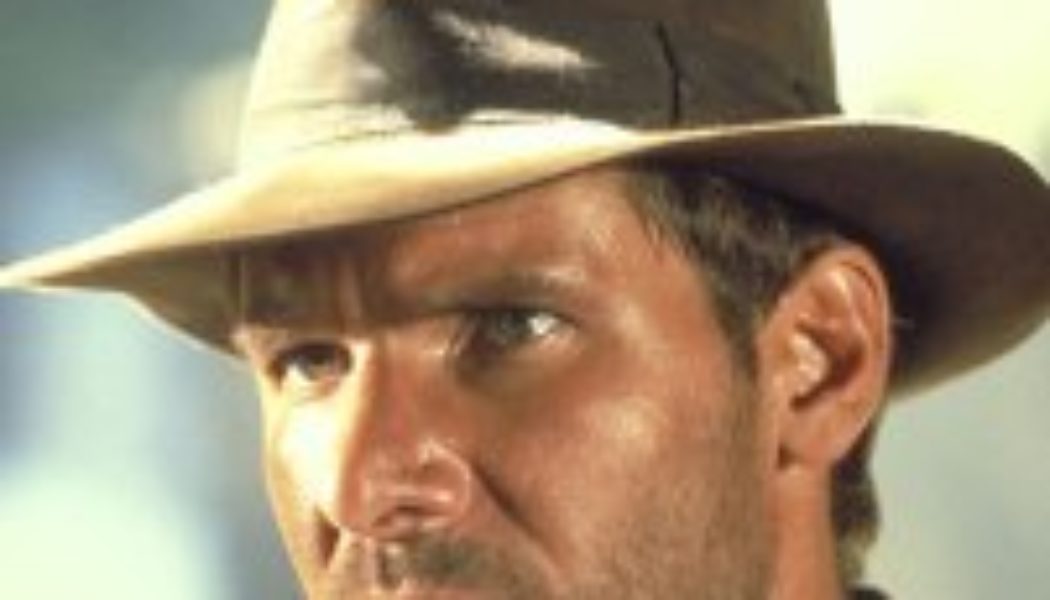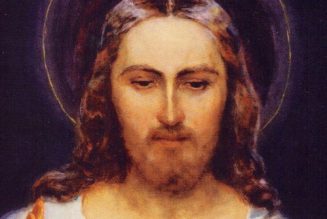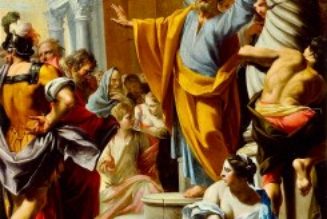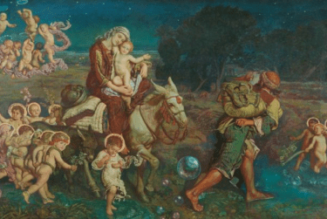There is only one fictional character who embodies the American spirit in its essence and its entirety, and who is real enough that it seems he should have existed: Indiana Jones, the swashbuckling American archaeologist.
 Forty years ago today, Raiders of the Lost Ark—perhaps the greatest action-adventure movie of all time—was released.
Forty years ago today, Raiders of the Lost Ark—perhaps the greatest action-adventure movie of all time—was released.
A people, a civilization defines itself largely through the heroes that it adopts and celebrates. These heroes may be entirely mythical: We think of the Homeric epics, which tell the story of Odysseus, who overcomes many trials in his ten-year journey home after the Trojan War; of Lohengrin, the German knight who rescues a noblewoman; of Robin Hood, who for the English embodies ideals of justice and resistance to corrupt government; of William Tell, the Swiss hero who killed a tyrant. Some heroes existed in fact but have been so encumbered by legend that it is difficult to know where history ends and myth begins: Gilgamesh, a king of ancient Mesopotamia; Brutus, the Roman assassin of Caesar; the Scottish freedom-fighter William Wallace; the Count of Egmont, the Dutch noblemen who resisted a Spanish invasion; George Washington, who led a fledgling American nation in victory against the mighty British Empire and who was so honest that he confessed when a boy to cutting down his father’s favorite cherry tree.
America, as a young nation, still searches for appropriate epic heroes. Though Washington, Paul Revere, Benjamin Franklin, and Abraham Lincoln—among others—have partly satisfied this need, the historical record is too clear so as to ensconce these figures in the necessary mists of legend that turn a hero into a truly epic hero. Even those historical figures who are shrouded in legend—Johnny Appleseed, the steel-driving workman John Henry—capture only a part of the American ethos: in the former case, the idea of a fertile and growing nation, and in Henry’s case, a celebration of hard work and an anxiety about technological progress. Too, what we often call “superheroes”—comic-book creations like Superman and Batman—though instructive in many ways, are too far-fetched and obviously fictional to meet the American need for the perfect epic hero.
There is only one fictional character who embodies the American spirit in its essence and its entirety, and who is real enough that it indeed seems that he should have existed: Indiana Jones, the swashbuckling American archaeologist of the 1930s, 1940s, and 1950s, brilliantly portrayed on the silver screen by actor Harrison Ford.
Created by Hollywood directors George Lucas and Steven Spielberg at the end of the 1970s, the character of Indiana Jones (called “Indy” by his friends) draws on previous fictional characters in American film—from the protagonists of the cliffhanger serials of the 1930s to which Mr. Lucas and Mr. Spielberg thrilled as boys, to heroes like Harry Steele (portrayed by Charlton Heston) in Secret of the Incas. Mr. Spielberg and Mr. Lucas developed this heroic character at a time when Americans were again seeking big-screen heroes. The 1960s and 1970s were a period of disillusionment for the United States, as the unpopular Vietnam War and social unrest sapped American self-confidence and the belief that the country was a force for good in the world. In cinema, the hero was replaced by the anti-hero, with the result that the vast majority of films seemed to lack clear moral compasses: One thinks of Midnight Cowboy (1969), Taxi Driver (1976), and Apocalypse Now (1979), among many others.
Mr. Lucas’ blockbuster Star Wars (1977) provided the first corrective to this trend, in a story that pitted the forces of good against those of evil in dramatic fashion. Though the film was set “a long time ago, in a galaxy far, far away,” it was clearly an American project with American actors in the three lead roles (including Mr. Ford as the mercenary pilot, Han Solo). At the height of the Cold War, it was not much of a leap to equate the Rebel forces in the film with the United States and Darth Vader’s Galactic Empire with the Soviet Union. Indeed, only six years later, President Ronald Reagan would use the language of Mr. Lucas’ “space opera” in deeming the Soviet Union an “evil empire.”
Star Wars whet the public’s appetite for the rebirth of silver screen heroes… of an American variety. John Wayne’s day had passed; James Bond was British; Clint Eastwood in both his westerns (The Outlaw Josey Wales, High Plains Drifter) and as roguish cop Harry Callahan (Dirty Harry) was more gritty anti-hero than pure hero. Where was the quintessential American hero? Enter Indiana Jones, first seen in 1982’s Raiders of the Lost Ark, then in Indiana Jones and the Temple of Doom (1984), Indiana Jones and the Last Crusade (1989), and Indiana Jones and the Kingdom of the Crystal Skull (2008).
His name itself is emblematic of America: The state of Indiana lies in the Midwestern heartland of the country, and his surname is often used as a stand-in for the typical American family (“keeping up with the Joneses”). He has a touch of the comic-book superhero, in that by day he is an unassuming professor of archaeology at Marshall College in Connecticut. But when he is on vacation or sabbatical, Professor Jones transforms into a fearless action hero, engaging in fisticuffs with competitors and enemies and expertly brandishing his bullwhip (“You’re a teacher?” asks one character incredulously; “Part-time” is Jones’ response.). When we first meet Indiana Jones, he is on an archaeological mission in South America, attired in his trademark brown fedora, leather jacket, and khaki pants, a satchel slung around his shoulder and the bullwhip and a pistol at his side. This is his action-hero costume. Indeed, it became a cliché in the films that Jones must not lose his hat, lest like Samson losing his hair, his strength is sapped out of his body. The ubiquitous hat is grasped to safety by Jones under descending stone doors; it blows back to him across the ground after he nearly is killed going over a cliff; it even stays on his head when he is washed overboard into the ocean. Like the comic-book superhero, Indiana Jones also has an Achilles’ heel, akin to Superman’s kryptonite: Indeed, Jones’ fear of snakes almost proves his undoing in two scenes.
But Indy is more epic hero than superhero: Though he displays strength and courage, he is not superhuman. His feats of daring are, taken individually, within the realm of the possible… if just barely. True, no one would survive the series of escapades in which he engages in Raiders of the Lost Ark, say: defeating assassins in the streets of Cairo, escaping snakes and suffocation in a sealed tomb, narrowly surviving a fistfight with a Goliath-sized Nazi, sliding beneath a speeding truck to avoid being crushed, riding a German U-boat across the ocean undetected…. The dice would eventually roll the wrong way in real life. Yet no superhuman superpowers are needed for Indy to overcome these obstacles—just a healthy dose of prowess and luck. “I’m going after that truck,” Indy declares in Raiders, referring to a German truck transporting the Ark of the Covenant. “How?” asks his sidekick Sallah. “I don’t know; I’m making this up as I go.”
Indiana Jones embodies other characteristics of the classic epic hero: He battles evil in the form of Nazis, Communists, and murderous cultists; he descends into darkness, whether that is being captured by the evil Thuggee cult in Temple of Doom, or coming face-to-face with Adolph Hitler himself in The Last Crusade; he at times relishes danger simply for danger’s sake (in a memorable scene in The Last Crusade, Jones’ father glares at his son in chastisement as the latter cackles with delight after foiling their Nazi pursuers); he seeks out “fortune and glory,” as he says in The Temple of Doom; he is occasionally tempted by women who may interfere with his ultimate goal—most clearly in the form of Elsa, the archaeologist who works for the Nazis in Last Crusade; though brutal when dealing with enemies, he is gentle with friends and the innocent (tipping his hat to Catholic nuns in Crystal Skull); he has guides in all the films (the treacherous Sapito, the young Short Round, his long-time friend Sallah, his son Mutt); he comes to trust and believe in the gods/God by the end of at least two of the films; and he accomplishes his goal in some way by the end of each film, by defeating his enemies if not always by acquiring the object of his archaeological quest.
Indiana Jones also reflects a truly American character, partly that of the “hustler” as described by historian Walter McDougall. He is at times self-serving, seeking valuable artifacts like the Ark of the Covenant and the Sankara Stones because they will bring him “fortune and glory,” or perhaps because of simple rivalry with competing archaeologists (such as Forrestal and the Frenchman Belloc). Yet Indiana Jones the character develops over the course of the four films, so that by the third installment, The Last Crusade, he is fighting greedy fortune hunters for precious objects that “belong in a museum” for all the world to enjoy. Even at the end of the first film, Indy is persuaded by the Nazi-collaborator Belloc not to destroy the Ark of the Covenant in an effort to defeat the Nazis because of the object’s historical significance (“We are just passing through history,” Belloc hisses to Jones: “This… this is history.”) Again in The Last Crusade, the confluence of American interests with those of the forces of good is demonstrated in a scene in which Indy saves the diary of St. Anselm—which holds the clues to locating th Holy Grail—from being burned in a Nazi book-burning ceremony. Indy barks at Elsa, the archaeologist who is in cahoots with the Nazis: “You stood up to be counted with the enemy of everything the Grail stands for! Who gives a DAMN what you think?” It is this combination of self-interest and magnanimity that might be said to characterize Americans’ view of themselves: What is good for America is good for the world.
Like American legend John Henry, Indiana Jones eschews technology. He is not James Bond, employing the latest electronic gadgetry as his weapons. Indy wields only a pistol and a bullwhip as his weapons; he rides a horse as he chases Nazi trucks and battles German tanks. It is a typically American sentiment, borne perhaps of the American Revolution: that good will defeat evil no matter the odds, especially when Americans represent the good. In Crystal Skull, when Soviet soldiers have captured him and plan to execute him, Jones is asked if he has any last words. Indy utters in quintessentially American Cold War fashion: “I like Ike.”
Epic heroes are often celebrated in song as well as story, and it is no exaggeration to say that composer John Williams’ rousing main theme for the Indiana Jones movies played a large part in their success. One simply cannot listen to the first notes of the theme without being drawn into the swashbuckling world of the adventurous Indiana Jones, who remains our one true American epic hero.
[embedded content]
This essay first appeared here in March 2015.
The Imaginative Conservative applies the principle of appreciation to the discussion of culture and politics—we approach dialogue with magnanimity rather than with mere civility. Will you help us remain a refreshing oasis in the increasingly contentious arena of modern discourse? Please consider donating now.
The featured image is courtesy of IMDb.
Join Our Telegram Group : Salvation & Prosperity










